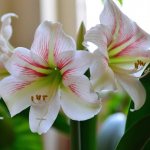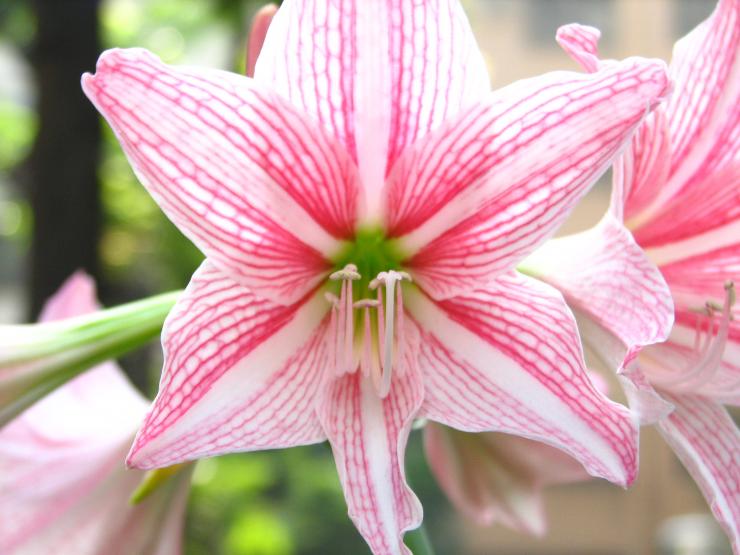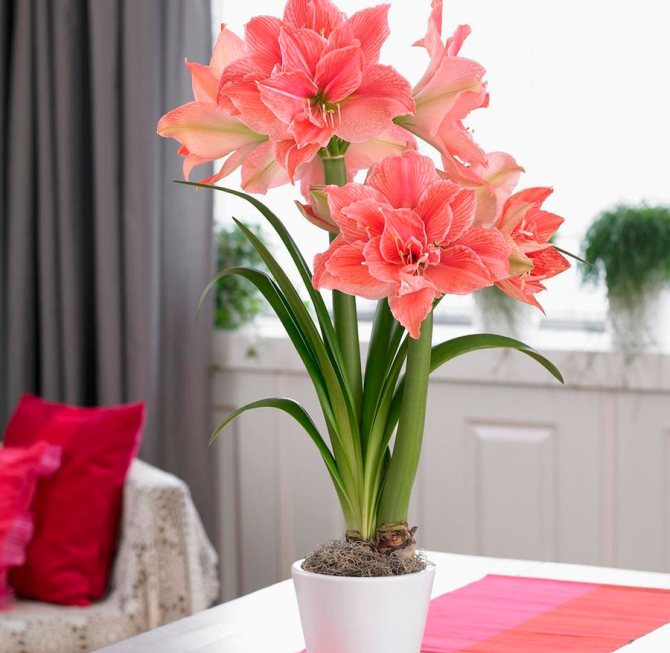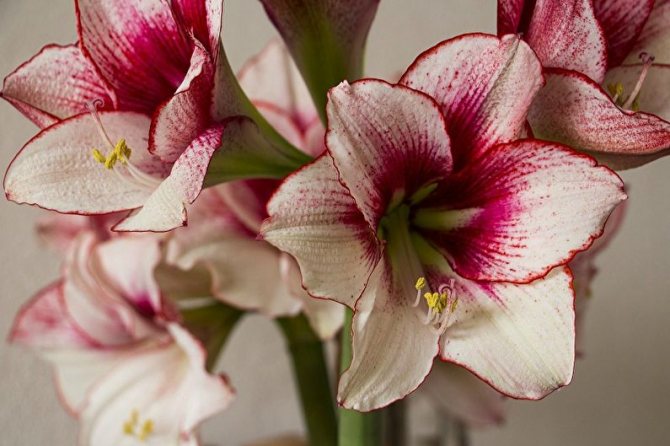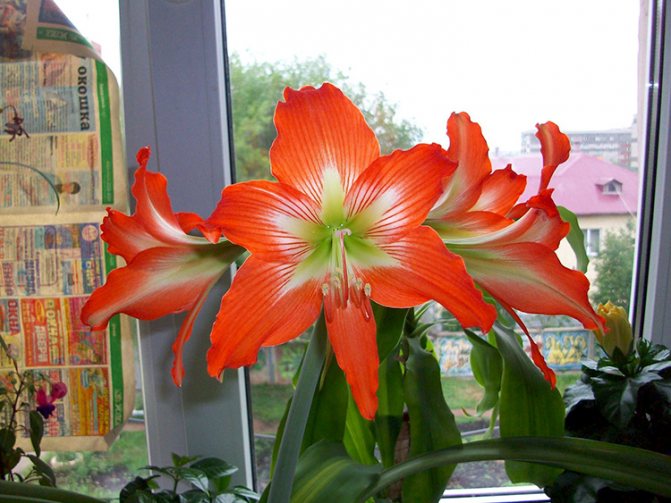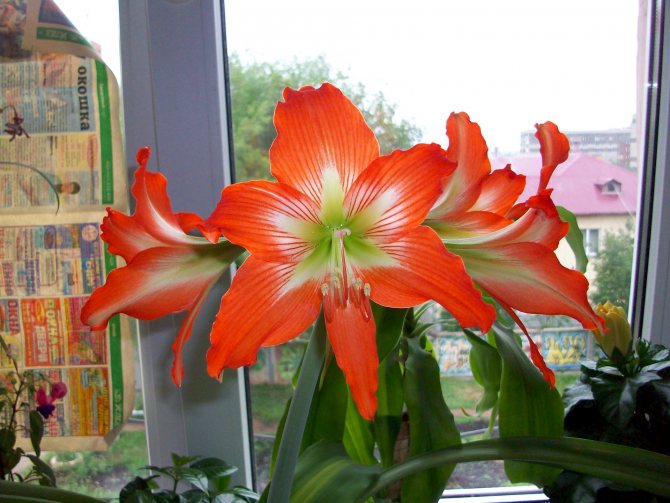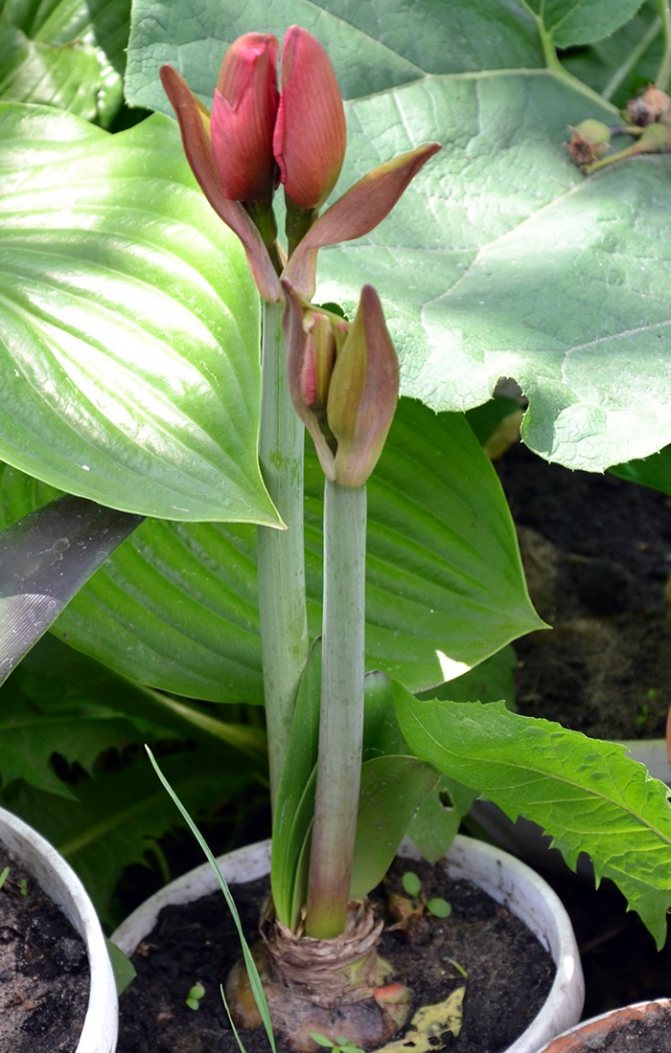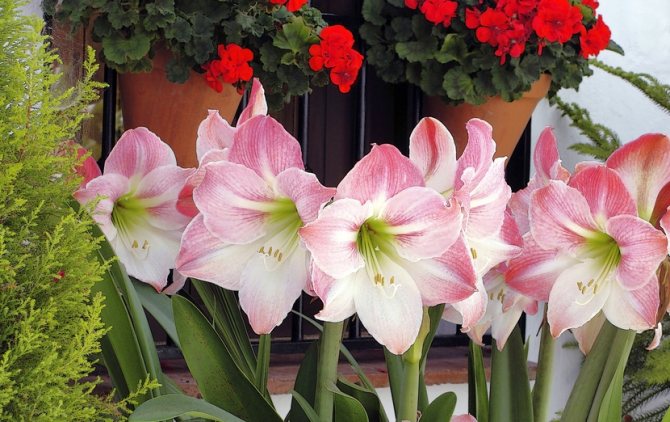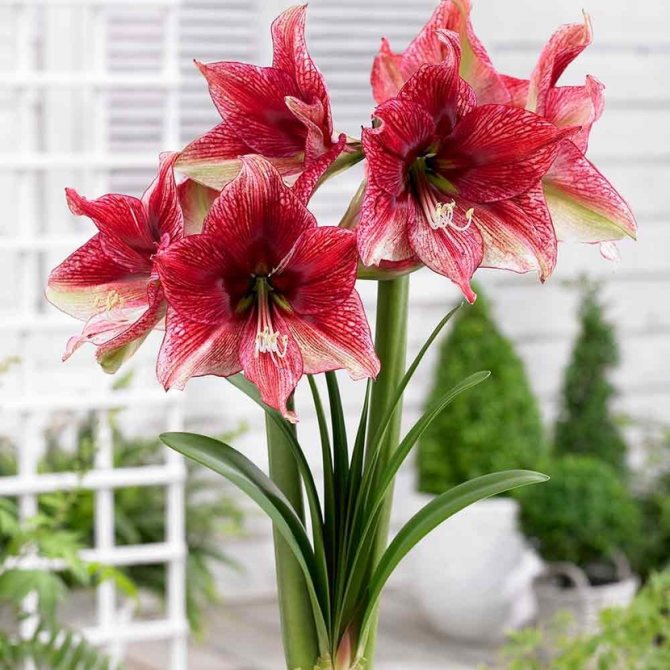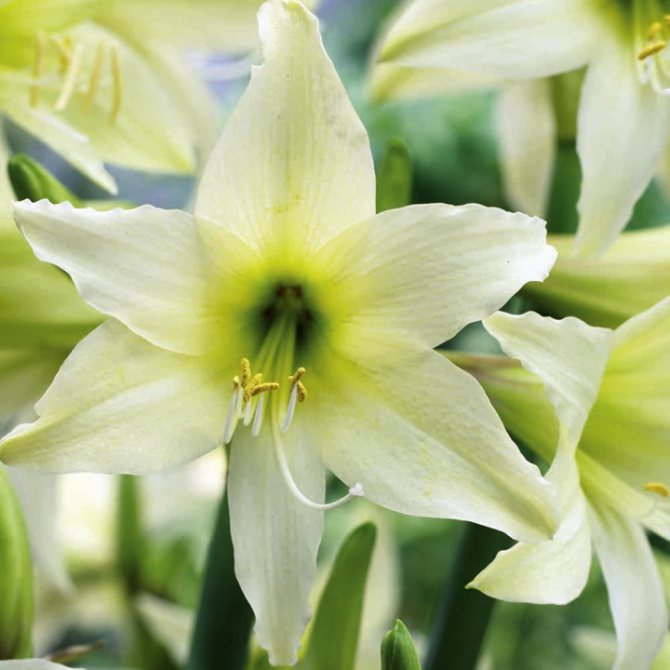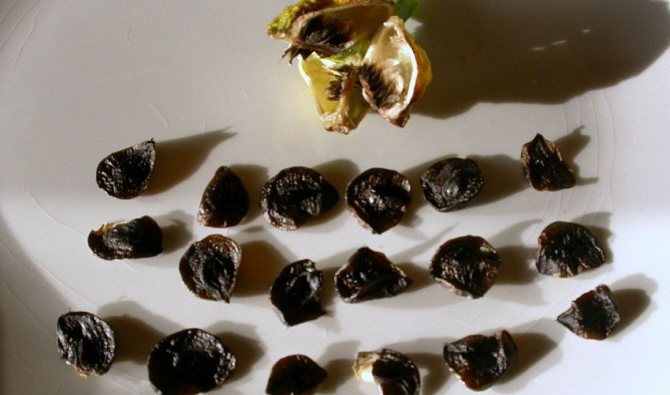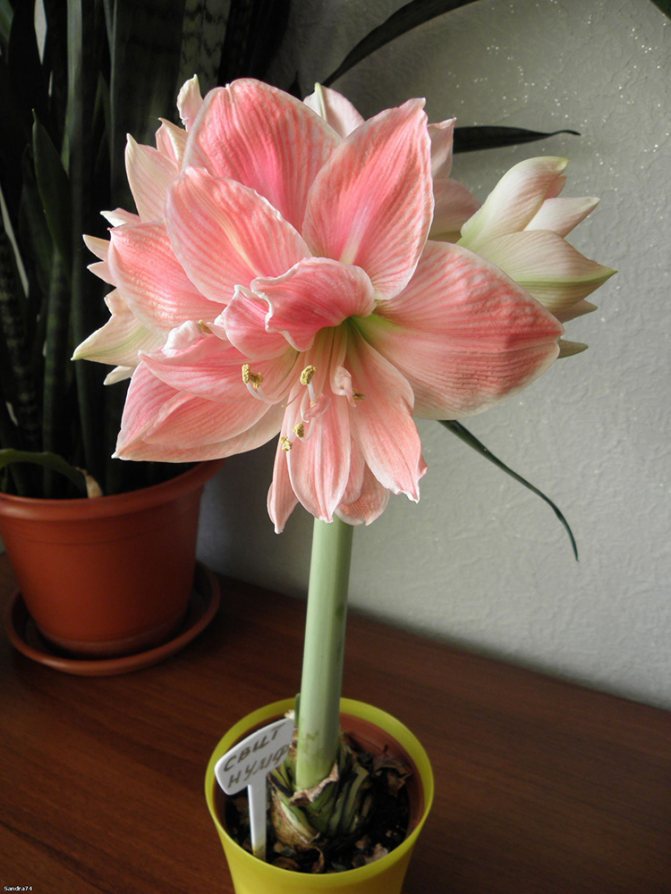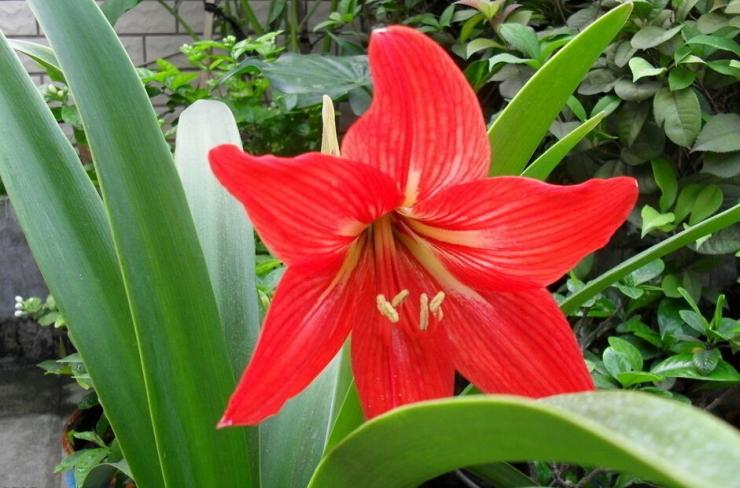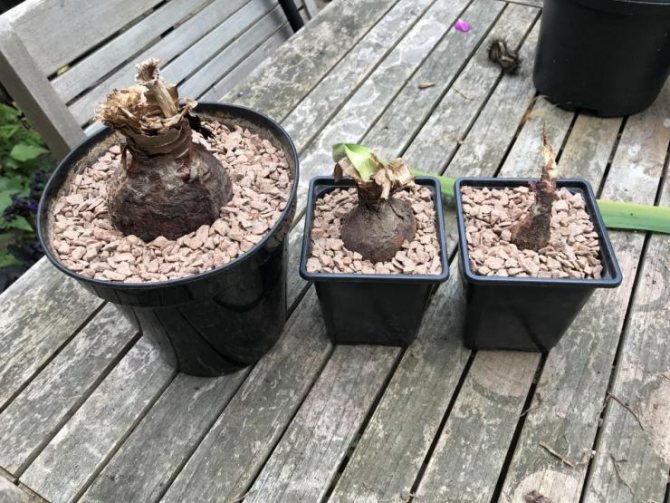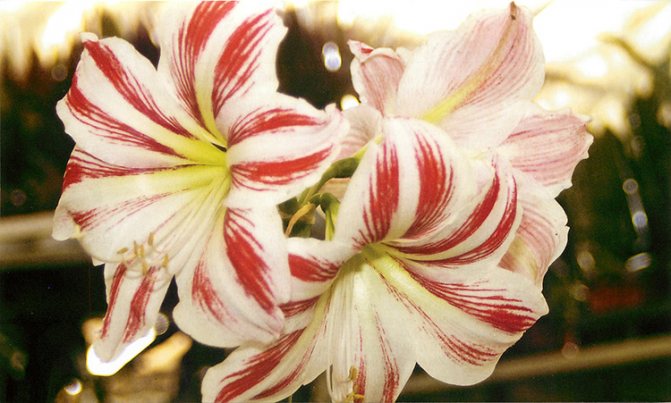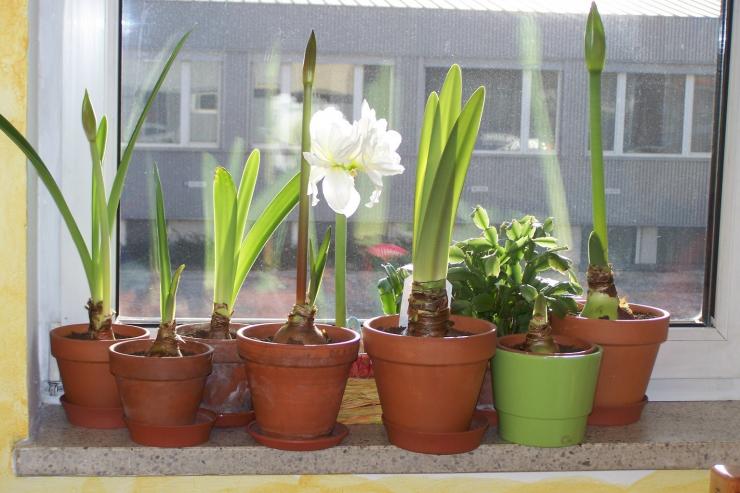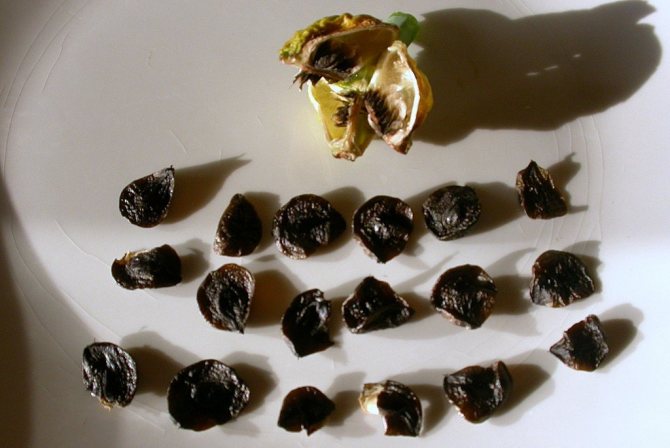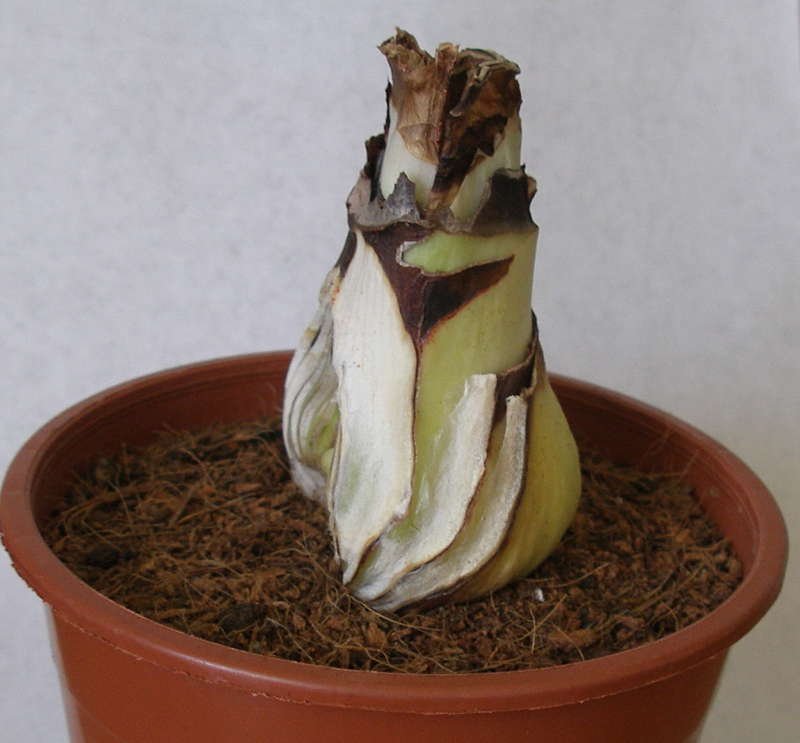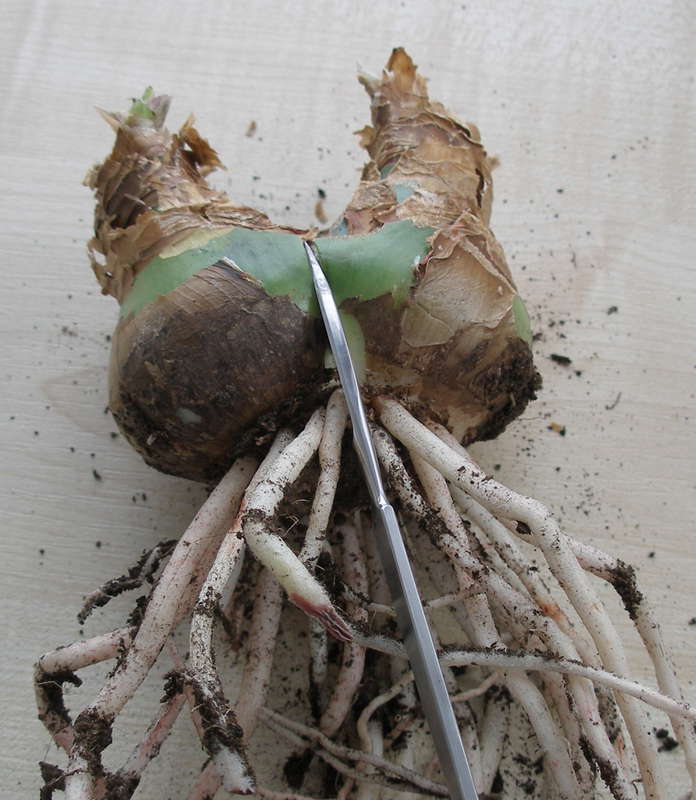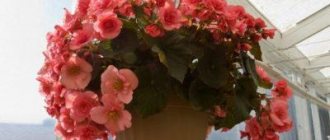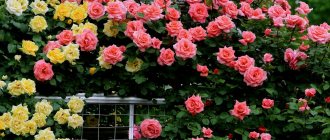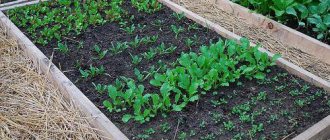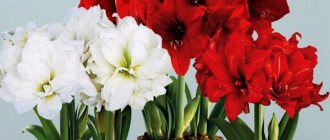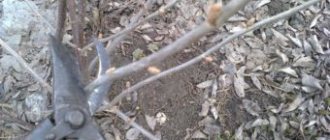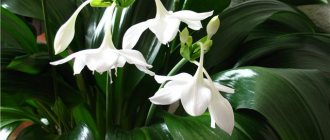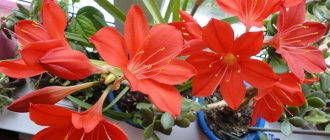General rules for plant care
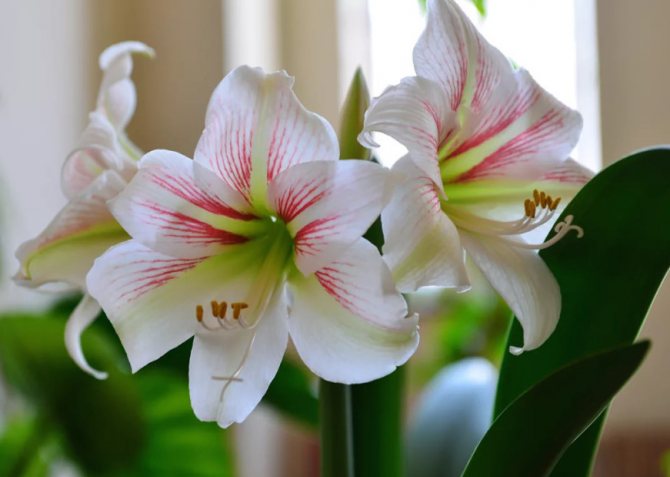
Hyppeastrum hybrid
- Bloom... Begins from early August to mid-September.
- Lighting... Like many indoor plants, it especially needs bright sunlight, but there is also a small nuance here: it must be diffused. An excellent place to keep in the house is the windows of the south-west or south-east side.
- Temperature... The optimum temperature is considered to be the limit from 17 to 25 C.
- Watering... At the beginning of the growth and development of a flower, watering is required a little, and after the appearance of peduncles, watering is increased, while preventing prolonged stagnation of moisture in the root system. Experienced growers prefer the bottom watering method.
- Air humidity... Requires normal room humidity for everyday use.
- Fertilizer... Feeding should be done at least twice a month. Initially, during the formation of a flower, it is precisely liquid mineral fertilizers intended for deciduous plants that are required, and after the appearance of peduncles, mineral fertilizers for flowering plants can be used.
- Dormant period... Falls in October - January.
- Transfer... This process is usually carried out only once every three to four years, after the plant has finished flowering.
- Reproduction... Can be propagated in the following ways: by seeds, babies and by dividing the bulbs.
- Parasites... Aphids, mealybugs and scale insects are especially dangerous.
- Diseases... It is worth wary of red rot, burn fungus and peronosporosis.
Planting and transplanting
Hippeastrum needs a transplant every 3-4 years. This is done while the plant is going through a dormant period - 30–40 days after the plant has bloomed (usually in August), and also in winter - before the hippeastrum begins to wake up from hibernation.
Choosing the right utensils for your flower is very important. The pot should be deep but narrow. The root system needs space for growth, and the bulb should take up most of the container, so that the distance from it to the edge of the pot is no more than 2-3 cm. Large space significantly slows down flowering.
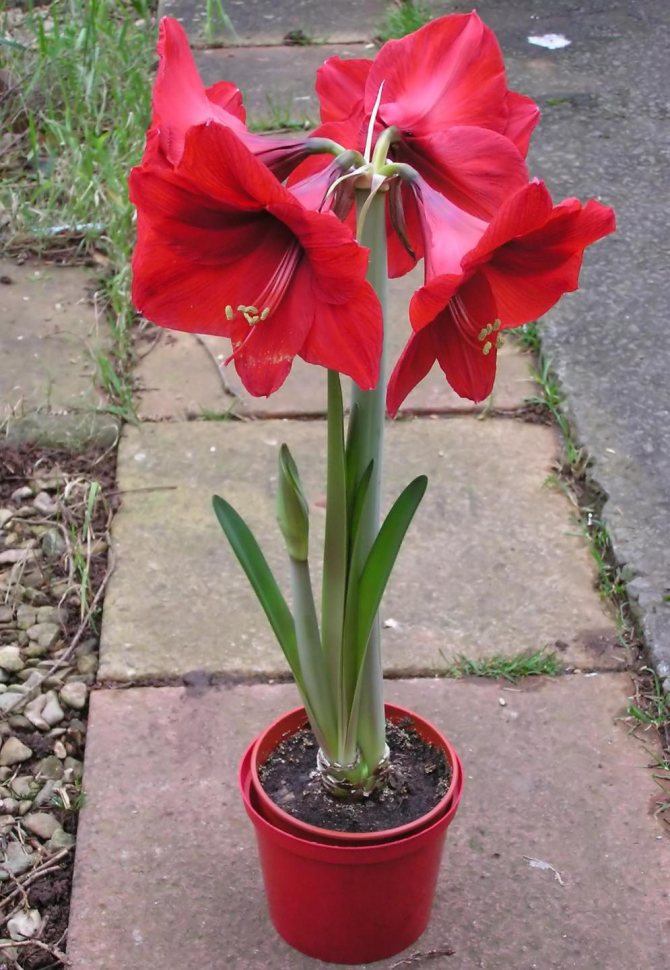

Choose a small pot for the hippeastrum so that the bulb fills it almost 2/3
Hippeastrum is undemanding to the composition of the soil. You can make your own universal humus-based mixture by taking the following components:
- 1 part compost;
- 2 parts of soddy clay land;
- 1 piece of deciduous land;
- 0.5 parts of rotted manure.
Remember that the flower needs drainage. Put pebbles, small clay shards, pebbles on the bottom of the pot.
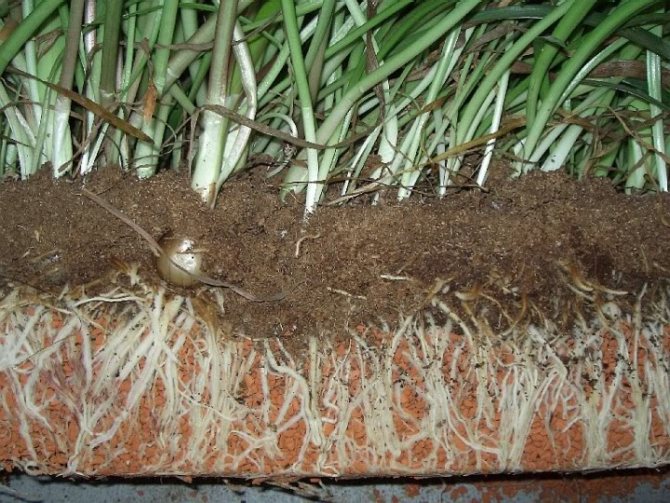

Be sure to drain the pot and use a quality substrate.
Treat the bulb with a weak solution of 1-2% Fundazole before transplanting.
Transplant by the transshipment method (without disturbing the earthen lump), be careful not to damage the roots in the process. Young leaves should also remain intact and healthy. Dig in the onion so that it rises by a third above the ground.
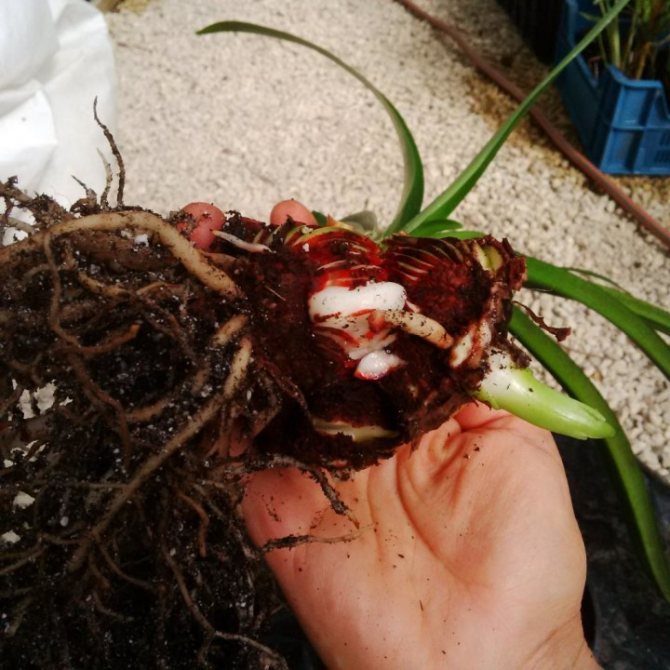

Repot the bulb carefully to avoid damaging the roots and leaves.
Separate the children that have formed around the bulb: they will be useful for further reproduction.
Features of flowering plants
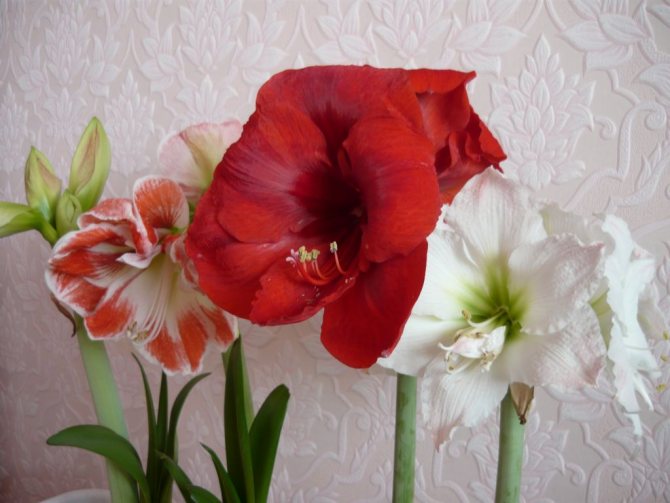

The hippeastrum flower opens 35-50 days after the flower arrow leaves the bulb. The buds are located vertically at first, covered with dense bracts forming a veil.Initially, when leaving the leaves, the buds are located vertically, later they begin to diverge and the flower opens completely.
From the beginning of opening of each flower, the duration of its decorative effect is 5-6 days.
At the moment of flower opening, the stigma blades are tightly closed. They begin to separate about 3-4 days after the flower opens, and by 5-6 they clearly separate and begin to bend back.
The perception of pollen by the pistil begins from the moment of separation of the lobes of the stigma of the pistil for 4 - 5 days. Anthers 2-2.5 cm long are attached to the staminate filaments in the middle and swing easily. Anthers are opened 5-6 hours after the flower opens. After the rupture of the anthers, the tissue is strongly compressed, their size decreases, bright yellow pollen comes out, surrounding the compressed septum. On the same flower, pollen matures earlier than the pistil.
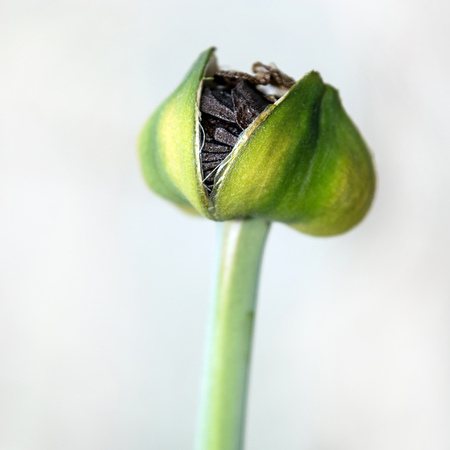

Seed capsule of hippeastrum
To obtain seeds, artificial pollination is carried out with a soft brush, applying pollen on the stigma of the pistil twice - on the 3rd day of flowering, when the blades of the stigma noticeably begin to move apart, and by 5-6, when they completely separate and begin to bend back. Pollination is best done with fresh pollen. The seed capsule forms 7-8 days after pollination of the flower and ripens 45-47 days. The diameter of a ripe box is 4-5 cm. There are 50-60 seeds in one box.
Growing problems and methods of their elimination
Improper plant care, in particular non-compliance with watering rules, can lead to the development of various diseases and even the death of a flower.
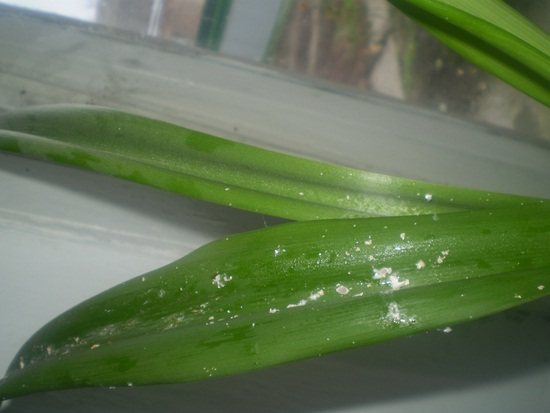

Red rot
Red rot develops as a result of waterlogging of the soil. Leaves become lethargic, rot appears on the scales of the bulb and roots. It is necessary to remove all damaged parts of the hippeastrum and root system, dry the bulb for a week, before planting in a new disinfected substrate, treat it with "Fundazol".
Downy mildew
The disease develops as a result of keeping the flower in conditions of high humidity and lack of ventilation. The leaves become soft, weak, silvery spots appear on them, the peduncles grow short or are completely absent. At the first signs of the disease, it is necessary to treat the hippeastrum with a specialized powdery mildew remedy, for example, "Fungicide", to change the conditions of keeping the flower, to take care of it.
Red fungal burn
The disease manifests itself in the formation of oblong red spots on all leaves of the hippeastrum. The affected areas first soften, then deform and dry out.
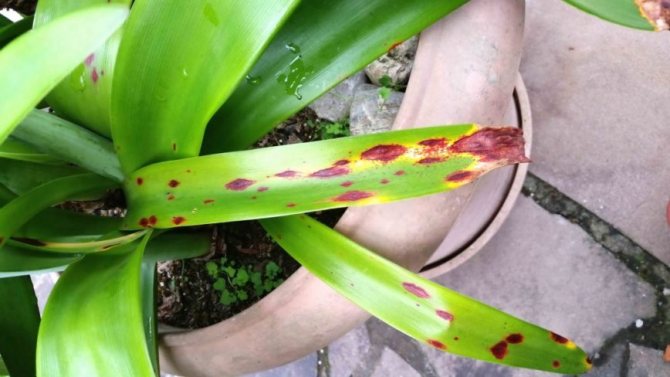

If you do not start treatment in a timely manner, the bulb will rot and the hippeastrum will die.
The cause of the disease is most often poor-quality planting material, and its development is facilitated by temperature drops and waterlogging of the soil.
To get rid of a red fungal burn, you need to treat hippeastrum with copper sulfate, "Hom", "Abiga-Pik", "Maxim", "Rovral" or "Topaz", let it dry for 2 days, transplant and loosen the soil daily until the formation of a new root system.
Leaves turn yellow: what to do?
Yellowed hippeastrum foliage may indicate a lack of nutrition, problems with the root system, or an urgent need for a transplant.
However, more often than not, the leaves begin to turn yellow in the fall, when the hippeastrum prepares for the dormant period. You just need to transfer the flower to a dark and cool place to rest, stop watering and immediately cut off the dry leaves.


Sowing seeds and growing seedlings
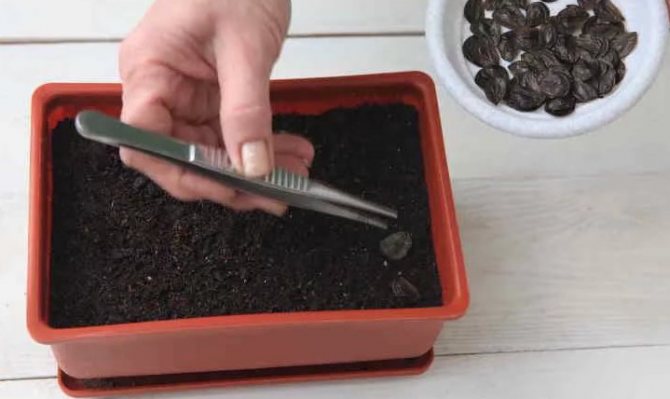

Planting hippeastrum seeds
Seeds must be sown immediately after harvest. The sowing substrate consists of a loose nutritious soil mixture.Compost-humus, leaf and peat soil, taken in equal proportions with the addition of sand, coarse perlite, is recommended. The physical structure of the soil is significantly improved with the addition of loose high-moor peat, previously neutralized, rotted sawdust and other loosening materials to the substrate.
Seeds are sown in dive boxes, bowls, and on a large scale - in the ground of the rack randomly. The seeds should lie loosely at a short distance from each other. They are sprinkled with a layer of up to 1 cm of finely sifted earth. Watering is carried out regularly, preventing the land from drying out. Seed germination begins in 2 weeks, mass shoots in 25-30 days. They sprout unevenly.
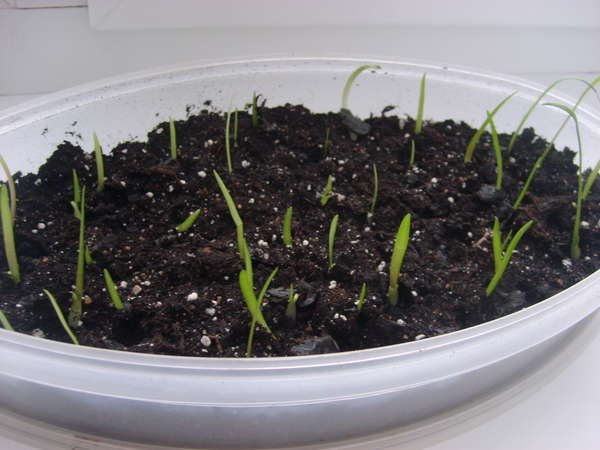

Seed shoots of hippeastrum
3 months after sowing, the seedlings have 2-3 leaves and a small bulb with a diameter of 0.5-0.7 cm. Root system with 2-4 large branched roots. Caring for seedlings after a dive consists in regular watering, removing weeds, maintaining a sufficient temperature (20-25 C), good ventilation of greenhouses in the summer. With a sufficiently nutritious soil mixture, the plants are not fed in the first months.
Choosing a soil for hippeastrum
Hippeastrum flowers are quite demanding on the composition of the soil in the pot, so it must be prepared especially carefully.
The most important requirement is lightness of the soil, which could quickly pass moisture through itself and provide a good air supply to the bulb.
It is also important that the soil contains a lot of organic fertilizers, and the level of its acidity does not exceed 6 pH values.
It is quite difficult to obtain such a soil mixture by self-mixing, so it is better to go to a specialized store and purchase ready-made soil for bulbous indoor flowers. True, it will not be superfluous to add a little sand to the purchased soil.
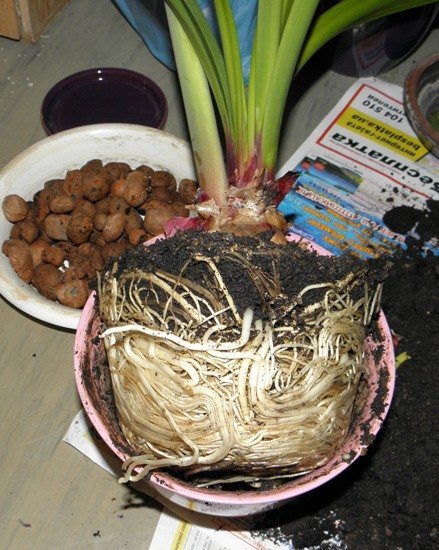

If, nevertheless, you decide to prepare the soil mixture for hippeastrum yourself, then use the following components for it (the ratio is indicated in numbers):
- clay-sod soil (2);
- leafy soil (1);
- humus (1);
- peat (1);
- sand (1).
Plant picking and further cultivation
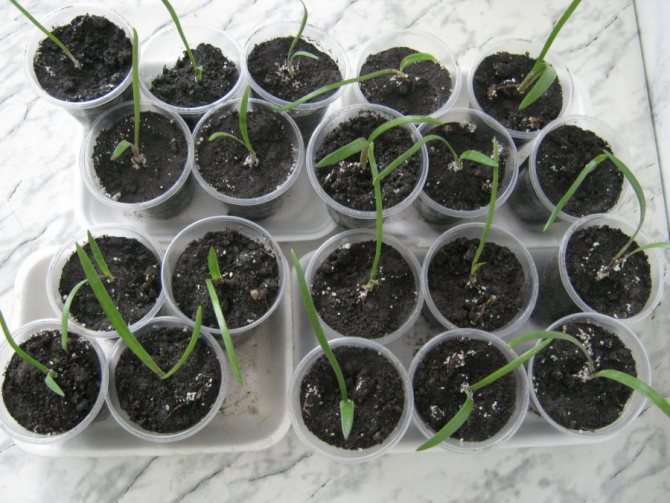

Transplanted hippeastrum seedlings
The pick is carried out after sufficient development of seedlings, about 4-5 months after sowing. For spring flowering and seed collection, sowing is usually done in June. With these sowing dates, a pick can be carried out in the spring of next year. If there is a free shelf space, the pick is done in October - November. Land for picking is used the same composition as for sowing. It should be loose, nutritious, moisture and breathable. In no case should you use heavy, dense soils.
Plants stay at the place of picking for 1.5-2 years. Dive seedlings are grown without a dormant period, the plants must be in a leafy state all the time and grow continuously. In this regard, during the entire growing period, they need to create conditions for active growth - optimal temperature conditions, regular watering, weeding and loosening, top dressing, treatment with pesticides.
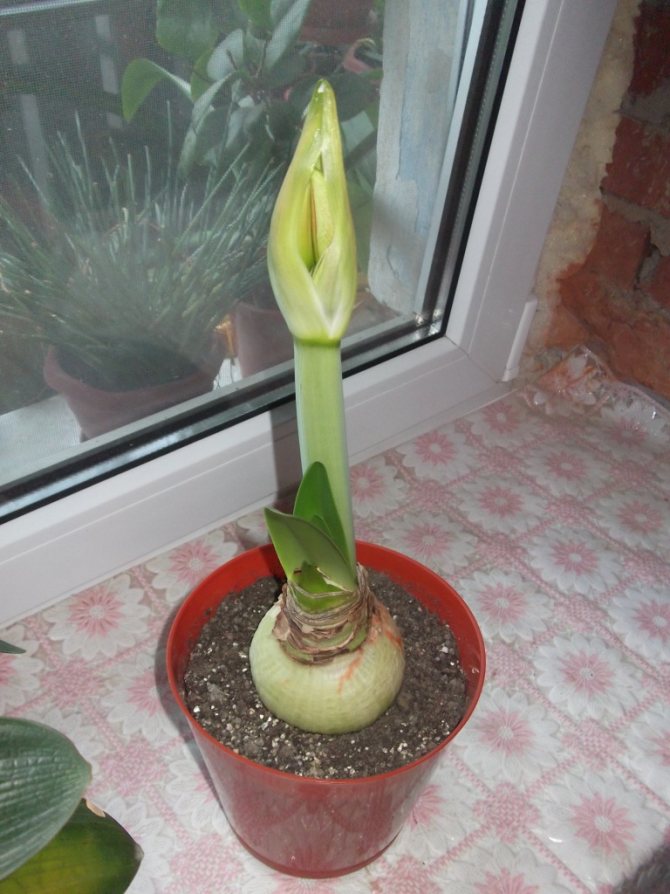

Development of the hippeastrum bud
The beginning of flowering of a bulb depends on its size. Bulbs with a diameter of 7 cm or more begin to bloom. The bulbs of the second analysis (from 4 to 7 cm in diameter) have buds of different ages, and the larger ones can also bloom this year, but much later. Intensive farming allows large bulbs to be produced in a shorter time and flowering can occur approximately 3.5 years after sowing. With poor agricultural technology, slow growth of the bulb, the beginning of flowering is postponed.
How to plant hippeastrum
You can plant hippeastrum without reference to the season of the year, focusing only on the desired flowering time - hippeastrum will bloom after about 5-9 weeks after the emergence of shoots.
At the bottom of the flowerpot, you need to lay a drainage layer of expanded clay, clay shards or broken brick, fill up the prepared slightly moistened substrate and deepen the bulb into it no more than ⅔ of the height.
If the bulb is damaged, it is necessary to first cut off the affected areas from it and soak it for half an hour in a fungicide solution (Fundazol, Maxim).
The damaged bulb should be deepened by a maximum of a quarter.
After planting, the flower should be placed in a warm, slightly shaded place, excluding watering until the peduncle reaches a height of 10 cm.
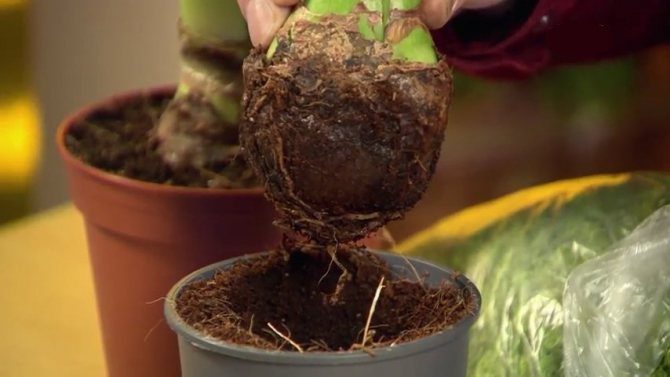

Watering and moisturizing
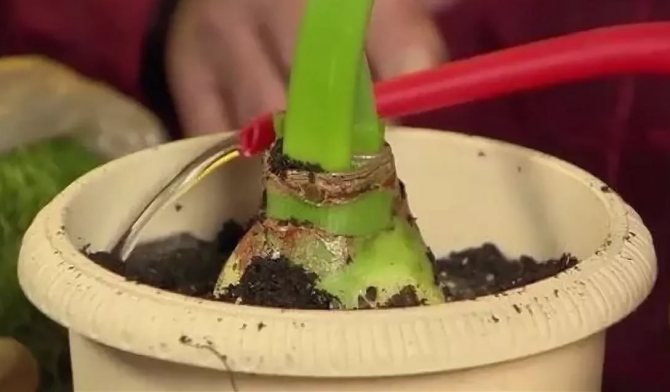

Hippeastrum are plants of warm greenhouses, therefore, when growing a bulb, the temperature should be constant - 20-24 C. In the summer, an increase in temperature to 30 C, subject to all conditions of agricultural technology, is tolerated by plants positively. In winter, they can withstand a drop in temperature to 3-5 C, but the growth and development of the bulb completely stops, and a long period of low positive temperatures negatively affects flowering, causes underdevelopment of buds, their deformation and reduction.
On hot dry days, the plant must be sprayed, watered regularly. During cloudy and rainy periods, watering should be limited. Excessive soil moisture, especially in winter, when combined with a low temperature, causes the death of roots, the spread of various fungal diseases. Plant nutrition is the most important link in the technological process, and great attention should be paid to this agricultural technique.
Possible problems
If the leaves of the plant begin to curl and deform, this is a sign of damage to the plant by the scabbard. It is usually extremely difficult to get rid of such a pest, so in most cases the plant is simply destroyed.
Sometimes red spots begin to appear on the leaves, which is a consequence of a fungal infection. In this case, all affected parts of the plant are removed, and the rest are treated with a fungicide.
Another disease that does not respond to treatment that hippeastrum can get sick is the mosaic virus. In this case, the growth of the plant practically stops, it does not bloom, and light yellow spots appear on the leaves. In this case, the hippeastrum must be destroyed as soon as possible.


Plant feeding


Since hippeastrum plants are in a permanent place for a long time without transplantation, it is necessary to periodically apply fertilizers to the soil in the form of dressings. For this purpose, various mineral fertilizers are used. Under production conditions, during the period of intensive growth, the following content of nutrients in the soil, mg / l, can be adhered to: nitrogen - 150-200, phosphorus - 200-250, potassium - 300-400, calcium - 250-350, magnesium - 50-70, Soil pH - 6.3-6.7.
During the period of intensive growth, there is a strong assimilation of nitrogen, potassium, calcium and magnesium. Therefore, when feeding, it is necessary to apply more nitrogen-potassium fertilizers. Plant feeding is carried out with dry fertilizers or nutrient solutions, taking into account preliminary agrochemical analyzes. Periodically, micronutrient fertilizers should be added to mineral dressings.
During the growing period, top dressing is recommended every 2-3 weeks.
High agricultural technology and continuous growth of bulbs for 1.5 - 2 years after picking make it possible to get large enough bulbs, which are planted in a permanent place for flowering. They are dug up in October, sorted, the largest are planted for flowering, and the smaller ones for growing. Digging the bulbs and planting in a permanent place can be carried out in early spring, providing only the highest and most painless transplant possible.
Diseases and pests
| Pest | Symptoms | How to get rid of |
| Mealybug | On parts of the hippeastrum, a white bloom similar to cotton wool appears, the growth of the flower slows down. | Remove the top layer of soil and damaged areas of the plant, mechanically clean the leaves from insects using a cotton pad soaked in alcohol, treat the flower three times with an interval of 7 days with insecticides (Aktara, Aktellik, Metofos). |
| Daffodil fly | Hippeastrum stops growing and flowering. | Treat the bulb with "Aktara", in case of severe damage, you will have to get rid of the plant. |
| Thrips | White spots and stripes appear on the outside of the leaves. | Treat the flower 2-3 times with Aktellik or Fitoverm. |
| Spider mite | A thin white cobweb forms on the hippeastrum, the leaves and peduncle become fragile, deformed, turn yellow, fall off, they are covered with "marble" spots. | Replace the top layer of soil, remove the affected areas of the plant, cleanse the flower from insects with a cotton pad soaked in soapy water, treat the hippeastrum with insecticides 2-3 times with an interval of a week (Arriva, Actellik, Metofos, Fufanon "). |
| Shield | A sticky bloom appears on the hippeastrum, the growth of the flower stops, the leaves and flowers fall off. | Wipe the windowsill with alcohol or soapy water, treat the plant with Fitoverm, Arriva, Permethrin or Fufanon. |
| Aphid | The insect feeds on plant juices, which makes its leaves and flowers lose their saturation. | Treat the hippeastrum with Aktara, Metofos, Arriva or Fufanon insecticides. |
Planting bulbs in a permanent place and preparing for flowering
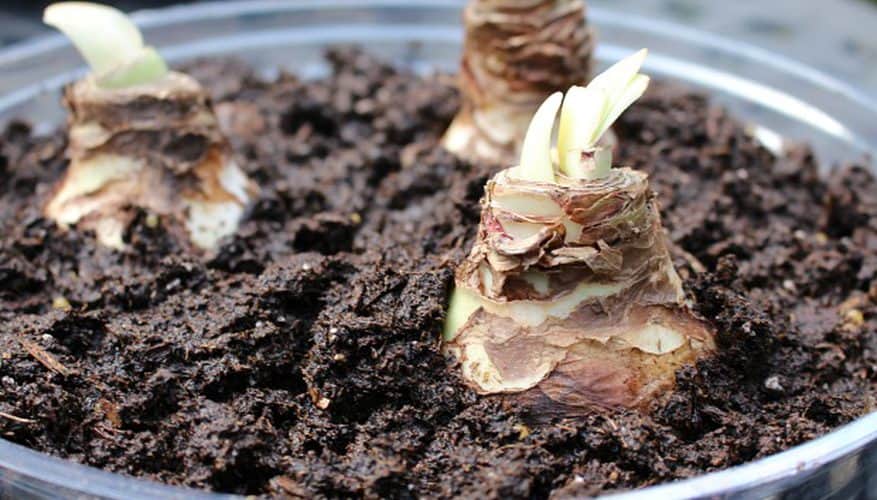

Hippeastrum bulbs
The scheme for planting bulbs in a permanent place for flowering 20 cm by 20 cm or 20 cm by 15 cm. You can also grow bulbs in a pot with a diameter of 13-14 cm or more. Before planting, the leaves are cut 2-4 cm above the bulb, cleaned of old dried scales, they try to preserve the roots as much as possible, cutting off only damaged and diseased ones. Before planting, the bulbs are treated with 0.5% foundation (50 g per 10 l of water). They are kept in these solutions for 0.5 h. Treatment with a dense raspberry solution of potassium permanganate for 0.5 h also gives positive results.
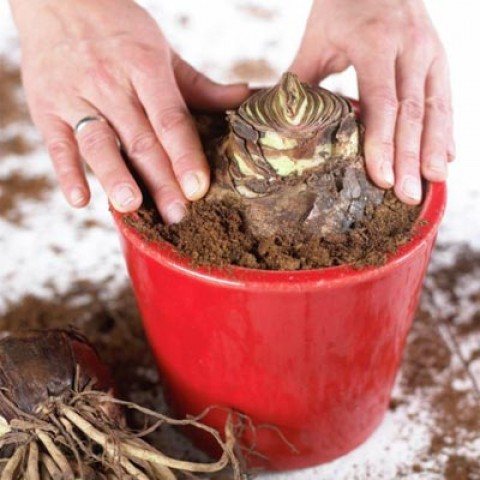

Planting hippeastrum bulbs
Land for landing is used the same composition as for picks. When planting, the roots are carefully straightened, the bulbs are placed so that it rises by half above the ground. Water well after planting. The period of active growing season for the accumulation of nutrients in the bulb and the laying of buds should last at least 7 months.
In the last year before flowering, the plant must be well looked after, fed regularly, systematically watered, treated with pesticides... During this period, the bases of assimilating leaves (scales) grow, new leaves are laid in the renewal bud and the bulb increases in volume. At the base of leaves with open sheaths, rudimentary inflorescences form and develop.
Choosing a pot for hippeastrum


The size of the pot will directly depend on the size of the hippeastrum bulb. Please note: When planting, the bulb should be placed in the middle of the pot, leaving 5 cm to each edge. Thus, the pot for this flower must be at least 15 cm in diameter.
As for the height of the pot, on the contrary, it should not be too large, because the bulb does not need to be completely immersed in the soil (the upper part of it remains half above the ground
). In addition, at the bottom of the pot it will be necessary to lay out drainage from stones, and above it there is still a fairly large layer of soil.
There are no clear restrictions on the material of the container for hippeastrum, but it is still better to use ordinary plastic pots for this plant.
This is due to the fact that ceramics are capable of intense heating in the sun, often causing the flower bulb to overheat. In this case, his death will be inevitable.
Dormant period of the plant
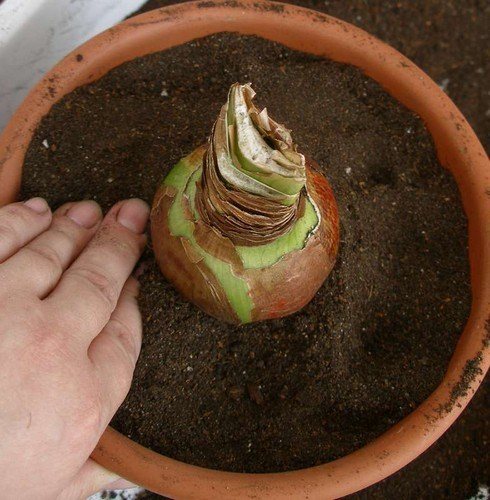

After the growing season, the hippeastrum needs a certain period of relative rest for 8-9 weeks. During this period, it is recommended to immediately stop watering, to achieve rapid and simultaneous drying of the substrate, which will contribute to a more uniform development of inflorescences and simultaneous flowering of plants. However, you must not dry the ground so that the roots dry out. They are perennial and should not die off during the dormant period. Very dry soil should be moistened.
The air temperature is recommended in the range of 13-15 C. For the flowering of plants by the New Year, a dormant period should be created from September 1-10 to November 1-10, provided that by this time the period of vegetative growth of plants is at least 7 months.
To accelerate flowering at the end of the dormant period by 1-3 weeks, the temperature can be raised to 23 C. For later flowering periods, the dormant period can be started accordingly later, thus increasing the vegetative growth period. If, after the dormant period has passed, distillation is not immediately started, the bulbs must be kept at a low temperature, but not lower than 7 C.
At the end of the dormant period, when most of the leaves turn yellow, they cut off all the remaining ones, and the bulbs protruding above the ground are coated with Bordeaux paste for disinfection. To prepare the paste, 1 kg of copper sulfate is dissolved in a small amount of hot water. Separately, stir in hot water 3 kg of fresh lime. Then the cooled solutions are poured off, stirring continuously, until a creamy paste is obtained. After the bulbs have passed the rest period, they are watered abundantly and the air temperature is maintained within 20-24 C, and the soil 18-20 C.


Peduncles begin to germinate by the end of the dormant period. The flower arrow in the hippeastrum appears before the leaves or at the same time. The maximum growth of leaves occurs after flowering. From the moment they appear in the bulb, inflorescences are already beginning to form for flowering next year. In the period of budding and growth of flowers, as well as the further vegetation cycle, a set of technological measures is carried out, provided for the cultivation of bulbs.


The bulbs are dug up in September - October. Watering of plants is stopped 3-4 weeks before. Then the leaves are cut at a height of 3 cm from the top of the bulb. The root system is completely preserved. After digging, the bulbs are dried at a temperature of 17-23 C in a strong air stream for two weeks and stored until planting at a temperature of 19 C and an air humidity of 70-80%. By this time, a peduncle with a height of up to 2 cm is formed in the bulb. Before planting, the bulbs are soaked in disinfectant solutions and planted for flowering.
Growing hippeastrum in a pot
When growing hippeastrum at home, flowers need to be given a lot of attention and care. While it is generally about providing a good place to grow, watering and feeding, this plant still has its own requirements for all of these aspects.
Watering hippeastrum
Hippeastrum in watering is quite whimsical, since it can neither be overfilled with water, nor allowed to endure a lack of moisture. Also, during each growing season of the flower, it requires special water balance:
- Hippeastrum requires most of the liquid during the flowering period. In particular, until the spike with a peduncle has grown to 15 cm, watering should be moderate, allowing the topsoil to dry out between waterings.
However, immediately after the flowers appear, watering should be intensified, although this does not mean at all that there should always be a swamp in the pot. Excess moisture can ruin the hippeastrum. - In the periods before and after flowering, watering should also be moderate, with the topsoil drying out.
- When the plant goes to rest, it will need moisture no more than once every 1.5 months. In this case, it is worth adding a lot of liquid to the soil.
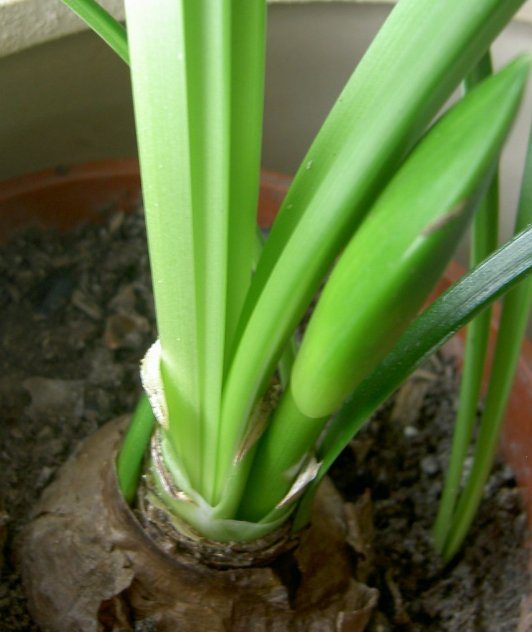

Please note that water should not fall on the bulb - it should only be poured into the soil.
Fertilization and feeding
Fertilizer for hippeastrum must be chosen taking into account the stage of flower development. In addition, it is important to alternate mineral and organic feedings.
As the first, it is better to buy special fertilizers intended for bulbous indoor plants. Top dressing of the hippeastrum takes place according to the following scheme:
- when the plant blooms, we enrich the soil with nitrogen, potassium and phosphorus;
- when the plant is just beginning to develop from the bulb - with nitrogen and potassium;
- a month before the plant should go into the dormant stage, all feeding should be stopped.


Best of all, hippeastrum responds to potash fertilization. In general, soil fertilization should be done every two weeks, but nutrients should not be applied to dry soil.
In addition, if you have just transplanted or planted hippeastrum, the first feeding should be done no earlier than after 1 month.
How to make hippeastrum bloom?
It often happens that the bulb gives arrows with leaves for several years in a row, but the peduncle does not appear on it in any way. The first reason may be a bulb that is too small, which simply does not have enough strength to bloom, although the reasons may be hidden in leaving:
- If the bulb is small, it must be fed so that it gains strength and then flowering will appear in a few months.
Use potassium and nitrogen to feed such a bulb, and do not forget to provide it with plenty of light.With intensive growing, the bulb does not need a dormant period, that is, feeding the hippeastrum can be carried out until the peduncle appears.
- In order for a flower to appear, it is important for the bulb to restore its strength and lay an arrow that appears only after every 4 leaves.
- The reason for the lack of flowering may be a lack of nutrition, which is even strong
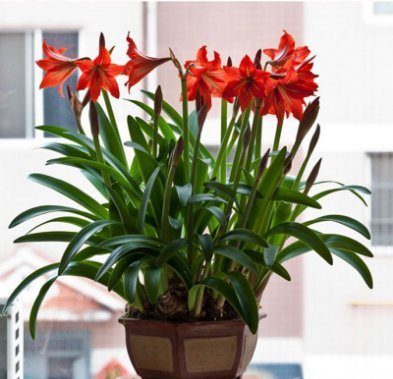

the bulb will not be able to release the arrow.
To prevent this, try changing the topsoil of the plant pot annually, and replanting it every two years.Also, do the correct and timely feeding in accordance with the needs of the flower.
- Take care of sufficient lighting, since in the absence of it, photophilous hippeastrum will also not bloom. Sometimes, even during a dormant period, the bulb should be left on a lighted windowsill.
- It is difficult to achieve flowering hippeastrum in too large pots. Therefore, make sure that no more than 5 cm remains from the bulb to the walls of the pot, and it is better if only 3 cm remains.
- Rest the plant after each flowering, which should last 2 to 3 months. During this time, it is important for the flower to stay in a cool and dark place.
Did you know? Hippeastrum are also found in the wild. In tropical latitudes, there are about 75 species of this flower, and although the number of varieties of indoor hippeastrum is several times less, they are much more attractive.
Rest period and transplant


Hippeastrum requires care after flowering. He needs help to regain strength and, if necessary, a transplant can be very useful.
The fact that the plant is ready for dormancy will be prompted by its leaves and an enlarged bulb (and of course a wilted flower).
For rest, the plant can be taken directly with the leaves to the basement. In 2-3 months, the bulb will take all the nutrients from the leaves and will be able to gain strength for another growing season and flowering. You can only remove the leaves after they turn yellow and dry.
The hippeastrum will be ready to be transplanted either before or after retirement.
During the period of active growth of leaves and flowering, the plant should not be touched, since with such manipulation you will disrupt its growth and can destroy it.
You can transplant this flower once every two years, however, annual transplants will also not interfere with it.
Vegetative propagation by dividing the bulbs
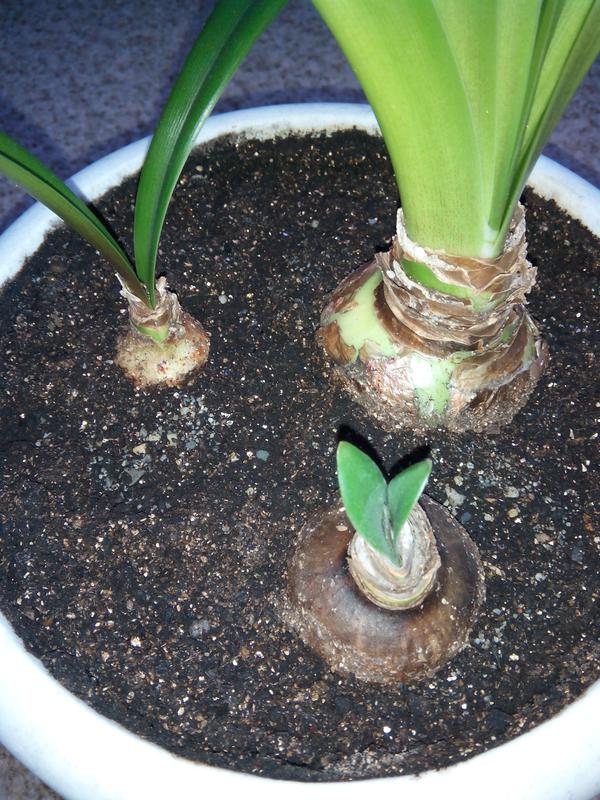

Vegetative propagation by bulb babies is a common method of propagation of the hippeastrum. In the process of growing, the bulbs constantly form babies, which are separated from the mother plant when it has its own roots, and grown independently.
Hybrid populations of some varieties grown in production form many children. Most of the highly decorative varieties of children almost do not form. In recent years, the method of vegetative propagation by dividing the bulbs has become widespread. For this, only large bulbs are used - with a diameter of at least 7 cm. The bulb is cleaned, the roots are completely cut off and treated with a solution of potassium permanganate.
Indoor plant varieties gippeastrum with photo: color catalog
A large number of varieties of the genus Hippeastrum are able to boast of excellent diversity due to the easy crossing process. Yellow, orange and even green flowers look wonderful in the house. The shape of the flower is also variable. Hippeastrum of any kind requires full home care. The photo below will showcase several beautiful, unpretentious varieties. Rarely, modern plants form babies, which contributes to the full preservation of the bulb. Let's get acquainted with popular varieties and hybrids, bred with love and attention.


Magnum is visible from afar with its deep red terry flowers with a transition to a cherry hue
The photo below is a fabulously beautiful white hippeastrum.


Alfresco is a terry variety with a greenish core and 3-4 rows of petals. The total diameter of one flower is 15 cm.


Ambiance pleases with a combination of red and cream shades and a large flower size
Among the favorite varieties, we will name the large-flowered Andes. Its double flowers bring great aesthetic pleasure.
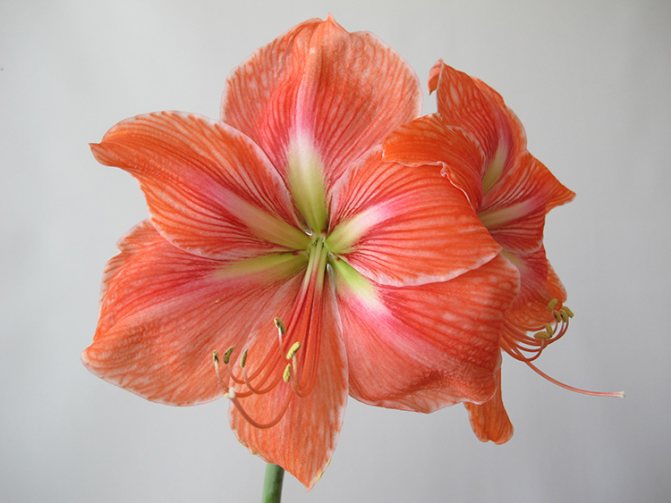

Gentle Andes is always pleasing to the eye
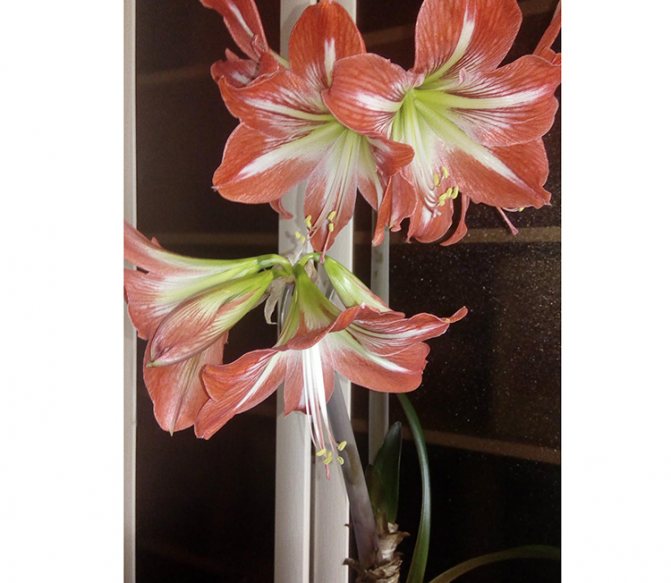

Baby Star delights with the waviness of the petals. There are 5-6 flowers on one high arrow
Black Pearl is translated as black pearl. The dark cherry blossoms reach 21 cm in diameter and represent an equal-pointed star.


Black Pearl has a black and purple coating
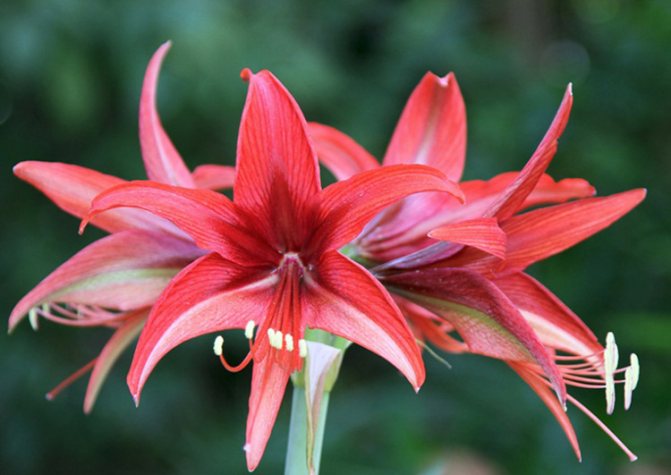

Bogota offers 4 flowers per peduncle
There are several other popular varieties, among which the pink chocolate green Chico and the light green Evergreen are especially interesting.


Chico's funny petals
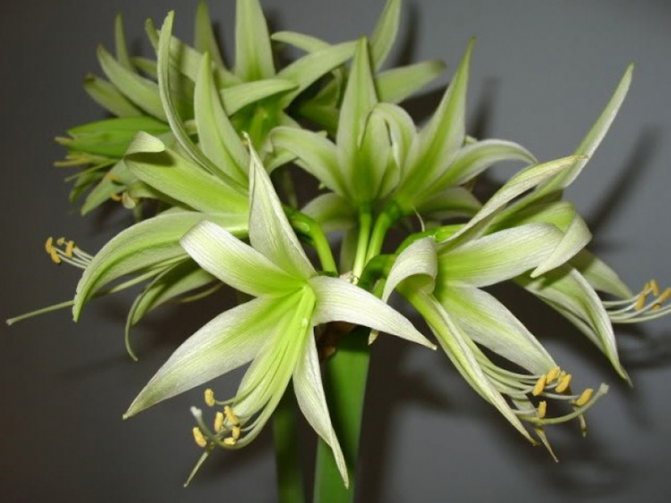

Unforgettable Evergreen - evergreen
When and under what conditions you need to plant a plant
The planting season is absolutely irrelevant, you can plant even in winter, if all the necessary conditions for growing are observed. First of all, you need to pay attention to the selected bulb, it must be: healthy, without cracks, red streaks, with good roots.
Did you know? Greek name
«
hippeastrum
»
translates as "rider's stars".
The ideal lighting option is bright sunlight or warm artificial light. Temperature - from 16 ° C. The planting site is a plastic pot with great depth but small width.
Any planting soil is suitable, but ideally it is necessary to combine: humus, peat, sand, turf. It is only necessary to deepen the bulb by half its size so that it can take root. The location for planting can be selected based on the amount of light, the ideal option is a window on the sunny side of the house.
Reproduction methods
What kind of breeding hippeastrum is easier and more effective? The first and second methods are used more often, the third is very rare: for the germination of seed, artificial pollination and freshly harvested seeds are required.
Children
During transplantation, a small element is carefully separated from the large parent bulb. The instrument is sterilized, the cut is disinfected with charcoal powder. After planting in an individual container for two years, the leaves are not removed from the growing flower, even during rest.


By dividing the bulb
The optimal period is November: by this time, the base accumulates the greatest amount of nutrients. After removing the scales, the large onion is divided into 4 parts, but not completely. Then the knitting needles are inserted so that the parts do not touch. The bulb is looked after as if it were an adult tropical specimen. After the leaves have formed, the plant is fertilized. The next year, the bulbs are divided, planted in flowerpots: four new flowers are obtained.
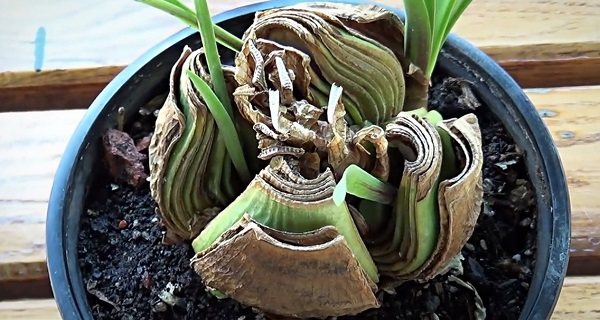

Seeds
The method is complex, laborious, only experienced florists can do it. It is important that the planting material is freshly harvested: for dried seeds, the indicators decrease to 1/3 of the total amount.


Why does not it bloom
This happens if the bush feels a lack of nutrients. Therefore, the dependence of the hippeastrum on timely fertilizers is direct.
Overfilling is allowed, too wet soil leads to rotting in the bulb. Hippeastrum is not up to flowering and not up to growth.
Diseases and pests are also the reason for the lack of flowering. Therefore, it is constantly recommended to inspect the leaves for spots and stripes. Common pests include spider mites, scale insects, mealybugs and daffodil fly.
If unhealthy signs are found, immediately help the bush. Treatment (spraying) with karbofors or actellik will help to save the plant. If the bulb is sick, then you can save it by cutting off the affected areas, which are then sprinkled with charcoal.
Therefore, in order to prevent harmful larvae, the bulbs are treated with hot water before planting.
And it is important: no hippeastrum will bloom in an extensive pot. Loves tightness. If you want blooming, use a narrow pot. 3-5 cm larger than the diameter of the bulb.
Optimal conditions for growing a flower
The practice of cultivating this plant shows that the beauty of the hippeastrum depends on the optimal parameters of temperature, humidity and illumination. Intense bloom provides a full dormant period in a dark, dry and cool place for at least 8-10 weeks. "Tired" hippeastrum most often gives small flowers on a short peduncle or does not bloom at all.
At the moment the bulb wakes up, the conditions should be gradually (but not drastically) changed: transfer the plant to a warm, but not too brightly lit room and increase watering to moderate. Thus, the formation and development of peduncles is stimulated. In cold climates, this process is greatly slowed down.
If a plant hits bright light from the dark in combination with excess moisture, it stimulates the rapid growth of the green mass, but noticeably inhibits the development of the peduncle. In order for the hippeastrum to develop fully, it is necessary to observe the growing conditions given in the table.
Growing conditions for hippeastrum at different periods of development - table
| Development period | Season (can be artificially displaced at the request of the grower) | Temperature | Humidity | Illumination | Recommended location |
| Dormant period | Mid September - end of January (when flowering once a year). | 10-12 ° C. | Light and rare hydration. | No lighting. | A dry basement, cellar, or just a dark place away from the window. |
| The beginning of the growing season (appearance of leaves) | End of January - beginning of February. | 25-30 ° C. | Poor watering (the land should be almost dry). | Dim light. | In the back of the room (not on the windowsill). |
| Vegetation period (flower arrow appears) | Early February. | Above 20 ° C - accelerates peduncle development. 16-18 ° C - slows down the growth of the peduncle. | Gradually increase the amount of moisture to a moderate level (the ground should be moist, but not wet). | Bright diffused light. | On the windowsill. |
| Bloom | Mid or late February - early or mid March. | Above 20 ° C - reduces flowering time. 16-18 ° C - Prolongs flowering. | Regular watering. | Bright diffused light. | South-facing windowsills with louvered windows. Rotate periodically around the axis to avoid deformation. |
| The period of active growth of leaves | Mid March - mid September. | 18-22 ° C. | Gradually reduce watering until it stops. | Maximum possible illumination. | Outdoors in a place protected from direct sunlight and waterlogging |
Types and varieties of hippeastrum: names and photos
The following are the common types of hippeastrum, from the description of which you can understand the richness of the varieties of this culture. All varieties of hippeastrum have certain characteristics and distinctive features.
Look at all the varieties of hippeastrum in the photo on this page, where you can get acquainted with the varieties:
Hypeastrum hybrid (Hippeastrum hybrida)
These types of hippeastrum, judging by the name, are distinguished by high decorativeness, duration of flowering, duration of preservation of cut flowers, good transportability in the phase of closed buds. The color of flowers in varieties of this species varies within the orange-red part of the spectrum, but there are white and greenish shades of flowers. The perianth of the hippeastrum has a short tube and a funnel-shaped limb. The stamens are curved, collected in a bunch, above which a pistil rises. The fruit is a tricuspid capsule with large flat seeds.
Hippeastrum Leopold (Hippeastrum leopoldii)
The bulb is round, 5–8 cm in diameter, with a short neck. Leaves are belt-shaped, 45-60 cm long. The peduncle is strong, two-flowered. Flowers 11-14 cm long and 17-18 cm in diameter, red in the middle, white at the top. Corolla pharynx greenish-white. Blooms in autumn. Grows on rocky mountain slopes in the Peruvian Andes. It is one of the ancestral forms of garden varieties of hippeastrum.
Hippeastrum spotted (Hippeastrum pardinum)
Plant up to 50 cm tall. Leaves develop after flowers appear, belt-like, 40–60 cm long and up to 5 cm wide, tapering at the base. Peduncle is two-flowered. Flowers on pedicels are funnel-shaped; perianth 10–12 cm long; pharynx greenish yellow; petals are elongated-claw-shaped, greenish-white, cream, with a reddish tint and in numerous small red spots; the outer petals are wider than the inner ones. It blooms in winter and spring. Found on rocky mountain slopes in the Peruvian Andes.
Hippeastrum parrot (Hippeastrum psittacinum)
The plant is 60–90 cm tall. The bulb is large, 7–11 cm in diameter. Leaves are belt-like, usually 6–8 pieces, 30–50 cm long and 2.5–4 cm wide, grayish green. The peduncle is strong, with 2–4 flowers. Flowers: tube wide-funnel-shaped, green-red in the fauces; petals are oblong, pointed, with red edges, with a green or yellowish-green keel, cherry-red stripes in the middle part. Blooms in spring. Grows in the forests of southern Brazil. Widely used in hybridization works; received many hybrids that make up the modern range of hippeastrum.
Hippeastrum royal (Hippeastrum reginae)
The plant is 30-50 cm tall. The bulb is round, 5–8 cm in diameter (the mother bulb weakly forms daughter bulbs). Leaves are linear-lanceolate, 60 cm long and 3.5-4 cm wide in the middle, tapering at the base (appear after flowers). Peduncle with 2-4 flowers. Perianth - funnel-shaped tube, red, whitish-green star-shaped pattern in the pharynx; petals obovate, pointed. It blooms in winter and spring. Grows in the mountain forests of Mexico, the Antilles, Central America, Brazil, Peru.
In culture, there are many hybrids of the royal hippeastrum:
Hippeastrum x gravine Melazzo - with glossy red flowers
Hippeastrum x spectahilis Lodd
Hippeastrum x jonsonii Bury
widely spread in the gardens of countries with tropical climates.
Hippeastrum reticular (Hippeastrum reticulatum)
The plant is 30-50 cm tall. The bulb is small, with a short neck. Leaves are lanceolate, usually 4–6 pieces, 30 cm long and 5 cm wide, tapering towards the base, thin, green. The peduncle bears 3-5 flowers. Petals obovate, claw-shaped, mallow-red, with numerous dark veins. Blooms in autumn until December. Grows in the forests of southern Brazil.
Hippeastrum reddish (Hippeastrum striatum)
Plants are 30-60 cm tall. The bulb is round, 5-9 cm in diameter, with a short neck and pale outer scales. Leaves are 30–40 cm long and 4–5 cm wide, light green. Peduncle grayish-green, flattened, with 2-6 flowers.Pointed petals; inner petals, tapering at the bottom, with a green keel to half the petal. It blooms in winter and spring. Occurs in humid shady areas of forests in southern Brazil. There are several forms.
Hippeastrum graceful (Hippeastrum elegans)
The plant is 45–70 cm tall. The bulb is ovoid, large, 7–11 cm in diameter, with a short neck. Leaves are belt-shaped, up to 45 cm in length. Peduncle with 4 flowers perched on pedicels. The flowers are funnel-shaped, large, whitish-yellow or greenish-white, with a long cylindrical tube, green, covered with purple spots or stripes, fragrant; petals obovate, with red stripes. It blooms in January and also in May and June. Inhabits the forests of Northern Brazil up to Colombia and Venezuela. In the fall, the leaves fall off; the bulbs should be kept warm and dry for the winter.
Hippeastrum striped (Hippeastrum vittatum)
The plant is 50–100 cm tall. The bulb is round, 5–8 cm in diameter. Leaves (usually 6-8 pieces) are belt-like, green (appear after flowers). Peduncle with 2-6 flowers on pedicels. Perianth with funnel-shaped tube. Petals are oblong-ovate, pointed at the apex, white along the edges, with a white longitudinal stripe between the edges and the median keel, in lilac-red stripes. Blooms in summer. Grows in forests on rocky mountain slopes in the Peruvian Andes.
Look at the photos of the hippeastrum, the names of which are listed above - on them you can see the characteristic features and distinctive features:
Description
The bulb has a round or conical shape, reaching a diameter of 50-100 mm. The leaves grow like a fan. Flowering is observed in winter. The peduncle has a length of 35 to 80 cm. Large buds (2-6 pieces) are formed at the top. The petals are of different colors (white, pink, orange). Each bud contains 6 petals, which are arranged in 2 rows.
As for the scent, the flower is practically odorless. The fruit is a capsule that develops after flowering. Over time, it dries and opens up. It contains black seeds, flat in shape. A feature of hippeastrum is that its seeds retain their germination for a long time.
ATTENTION! The leaves and fruit of the plant are poisonous, which must be taken into account if you have pets or children at home.
Useful video
You can find out more about the Hippeastrum flower in the video below:
Hippeastrum, a genus of the amaryllis family, has been very popular with gardeners from all over the world for several centuries for a reason. Today we found out why exactly, and also learned the correct ways of caring for this not too whimsical plant. The main thing in all this is to take into account all the factors, not missing any of them. Then you will definitely be able to grow many bulbs of this wonderful plant.
Bulb selection when buying
Ready-made hippeastrum bulbs are often sold at specialized points of sale. It is best to follow them in the spring - these are the best periods for planting and forcing. In extreme cases, planting can be done in the fall. Rule of thumb: the larger the onion, the richer it is in nutrients, and if sellers persuade you to buy small pieces “because they are young,” it’s better not to listen to them. And the point is not even that the plant will turn out to be larger and healthier, it will be blooming with a guarantee!
The second point on which you need to stop your attention is the neck and the bottom. They must be strong and free from damage. The top flakes should be dry and brown in color. There should be no red-brown spots, dents, seals and other deviations from the ideal shape. The healthy bulb is firm and dense to the touch.
What if the bulb is not sold naked, but in a pot? Inspect the upper part, its size and condition, as mentioned above. Lift the pot and look through the hole where healthy white roots should be visible.


How to make it bloom? Important nuances
Since the birthplace of the royal flower is the tropics of the Amazon, its dormant period falls on our summer months. This is due to the fact that the change of seasons in the southern hemisphere is opposite to the northern one. The genetic memory of indoor flowers is strong, most of which are brought from the southern hemisphere. Thanks to this, they grow wildly and bloom in lush bloom on the windows in winter. The trick of leaving is in the system of natural rhythms. That is why in the middle of our summer hippeastrum needs to be put into hibernation - genetically it has winter.
Florists, summing up their developments, advise:
Provide a mandatory rest period. This is the rule: there will be no peduncles without it.
Two cases when you need to achieve flowering hippeastrum. The first is if a bulb is planted. The second is an adult plant.
Having become the owner of the cherished onion, you must:
- choose the right size. Axiom: baby bulbs and just small - up to 4 cm in diameter will not bloom in the first year. And even on the second. Until they reach 7 cm. If you want a blooming hippeastrum in the next month, we buy only a large bulb. This will give out not one, but two peduncles.
- before planting it must be “woken up” - placed in warm water of 40-45 degrees for a couple of hours. Can be additionally treated with fungicide. Or hold for half an hour in a solution of potassium permanganate. Experts promise, after warm water procedures, flowering in a month and a half after planting.
And if you plant several bulbs of this exotic perennial at different times, then we get an alternate continuous flowering period - one after another. When you need to make hippeastrum in peas bloom, the algorithm of actions will be dissimilar depending on the method.
Benefit and harm
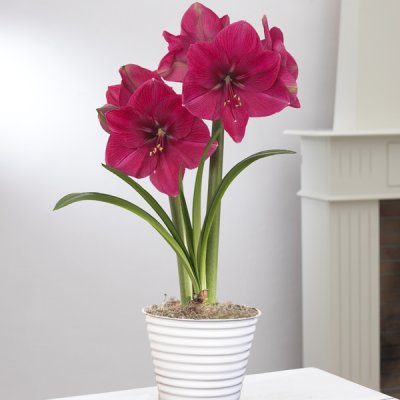

Indoor flowers Hippeastrum are poisonous plants. Care should be taken when handling bulbs. After any work, you should thoroughly wash your hands with soap and water.
Pets and children should not touch the poisonous parts of the plant in order to avoid allergic reactions and poisoning.
Hippeastrum - an interesting plant that can transform any interior. Its bright flowers leave no one indifferent. Fears can be caused by a forced dormant period, but with its correct organization, the hippeastrum will delight with flowering twice a year.

